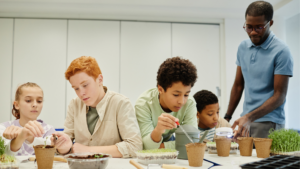
As I shared in our summer wrap-up, I recently returned for the first time in close to two decades to a role as a learner as I began an Ed.D. program at the University of Pittsburgh. I was (and still am) excited to explore new content, deepen my knowledge, and expand my perspectives. What I didn’t expect was that the first semester would leave me feeling skeptical about how much we really have the power to change our systems of learning and development. To be clear, I’ve always been a bit of a glass-half-empty person, but everything I do centers around a belief that we can grow and improve. That’s part of why I chose an Ed.D. program that’s grounded in improvement science.
So let’s start there. As I started my very first reading for the class – Learning to Improve: How America’s Schools Can Get Better at Getting Better – I was struck by the author’s positing that we need to transition from “going fast and learning slow” to “learning fast to implement well.” I agree and believe that schools and districts need to be both improvement-focused and learning organizations at their core. Yet, the book’s first publishing was in 2015. We are fast approaching a decade since this first writing, and we have not seen a fundamental shift in how schools operate. Even with the seismic upheaval of COVID, we focused on doing and changing rapidly, but very few districts with whom we work were really able to pause and to learn deeply from the changes they made. They did little to assess what was different and what worked and instead quickly returned to business as usual from before the pandemic. The issue at the heart of why is also outlined in the book – education does not have systems by which to scale. And without changes at the policy level or to the education value network, as Thomas Arnett outlined, innovators must continue to work outside or around the system.
Then, for the first time since it was released, I picked back up From A Nation at Risk to A Nation at Hope. I read and reread the phrase, “The promotion of social, emotional, and academic learning…is not another reason for political polarization.” Fast forward from 2019 to today; it has become just that, with the associated acronym “SEL” sitting firmly at the center of our current culture wars in education. A Nation at Hope is grounded in the deep work of a cross-sector and bi-partisan commission that thought they had a platform for unification. Yet there is not wide-scale evidence of the movement of the recommendations. Instead, districts and states that had been leaders in social, emotional, and academic learning now won’t even use the phrase.
So, where am I sitting now? There have been moments where I’ve questioned if I have any potential to make meaningful change if renowned commissions and notable authors haven’t yet been able to drive change at scale with their work. But something else was made clear in my first semester – we have to be concretely aware of our sphere of influence. As trite as it may sound, I can make a difference for those with whom I work most closely – continuing to advocate for and lift up the voices of the out-of-school learning community and field, continuing to learn more about what has worked and what hasn’t so I am advising with the greatest knowledge possible. And maybe my skepticism can be helpful to ensure I am not just jumping on bandwagons and going fast, but instead “learning fast to implement well” as the authors of Learning to Improve suggest we should do.



No comment yet, add your voice below!